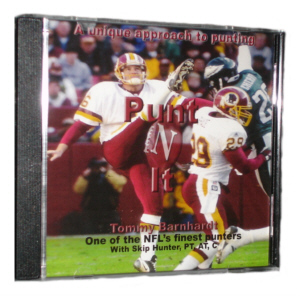|
GUEST EXPERT ARTICLE
It is preseason and as coaches we are preparing our offense, defense and special teams. When we do our kickoff unit we will all be looking for the kicker who can kick it into the end zone to avoid a return by the opponents kickoff return team and to make them start at their twenty-yard line. In high school we kickoff from the 40-yard line so we look for a kicker who can kick the ball 60 yards in the air. In addition, some state high school associations, including my state Virginia, have an additional rule prohibiting returns out of the end zone that enhances the commodity of a kicker with this ability.
Why then are we pleased when we find a kicker who can kick off into the end zone, but do not coach our punters to do the same thing to control field position? In other words why not let the punter start punting for the end zone when the ball is on the 40-yard line gong in toward the opponents goal line because punting the football into the end zone has the same effect as kicking off into the end zone.
The punter has two primary responsibilities: 1) punt the opponent as deep as possible and 2) limit the return. How can we be satisfied with the kick off result and not the punters when he punts it in the end zone? The same result is produced: no return and the opponent starting at the twenty-yard line. I realize the significance of the opponent starting deep in his territory and the percentage of scoring opportunities. However, I think those percentages are as much a result of the offenses conservative approach in that zone, and not necessarily the defensive effectiveness.
After contemplating this issue I came to the conclusion that this inconsistency did not represent my philosophy. So I allow my punter to bombs away when the field position is 40 and going in.
Having access to numerous punters from my kicking camps, I decided to test for the odds of a punter reaching the end zone from this field position. I simulated the ball being on the 40 and had five college and five high school punters test this theory. I allowed them to punt ten balls each trying to punt all balls in to the end zone. The results indicated that the college punters reached the end zone approximately 65% of the time and the high school punters reached the end zone 45% of the time.
The real result that impressed me was that the balls that did not reach the end zone ended up deeper inside the twenty with most of them landing and stopping inside the ten-yard line. From experience, I believe that freeing the punter to bombs away resulted in longer punts and better possible field position. Of course, coverage really determines field position so I am assuming that the coverage team is adept.
As a former punter, I can tell you that there are times when you are behind the center and feel as if you can punt the ball seventy yards. You have that in a groove feeling. These are the times you just want to punt it as far as possible and could if you were allowed to. But relying on feelings does not permit you to do something on command.
There are specific techniques that we teach punters to learn to drive the football farther and with less height. Once these techniques are learned the punter has the ability to punt the ball as far as his physical ability will allow. Consequently, he can perform in this bombs away situation.
I know the concern everyone has, a farther punt with less height means poor coverage. Well how high the punt goes does not correlate to a better net punt, contrary to popular belief. (This will be the topic of another article) It is the speed and coverage techniques of the coverage men that determine the net effectiveness of the punt. I have seen numerous 4.8+ second hang times returned for long distances and 3.5 second hang times have no return.
The results of my mini-study convinced me to allow my punter to bomb away from this field position last year. As a result, we controlled sixty-yards of field position and created excitement because the team knew the punter was going for the end zone. We taught our coverage men to expect longer punts and adjusted their coverage techniques appropriately. We took away a scoring opportunity for our opponent and worked more on our 20 defense.
In hindsight, we created a better field position exchange with our opponent. We started possessions deeper and more consistently in their territory because we did not have those short punts punters produce from swinging too easy to get the ball inside the twenty and mishit it. Our punter enjoyed this responsibility and worked hard at the proper techniques to execute it.
So, if you are happy with a kickoff into the end zone then why are you not happy with a punt into the end zone? Or can you be.
P.S. For information on the drive punt techniques you can read my book Kicking the Football. It is found in most bookstores or by visiting our web site at www.4thdownsports.com and using the Instructional Materials button. Learn more about Bill Renner >>> |

 Bombs Away Punting
Bombs Away Punting


 Doug and Tommy's Frequently Asked Questions
Doug and Tommy's Frequently Asked Questions




